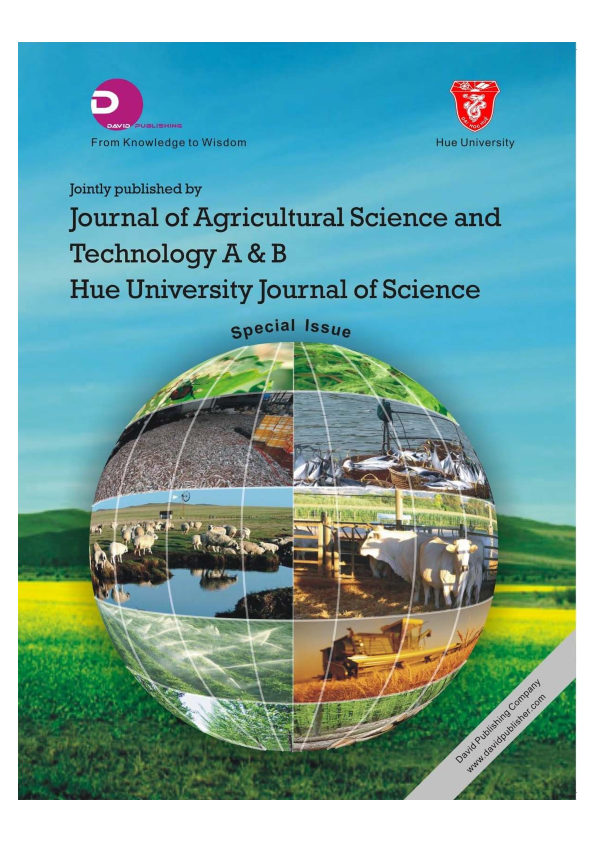DEVELOPMENT OF RAPD-DERIVED STS MARKERS FOR GENETIC DIVERSITY ASSESSMENT IN MELON (CUCUMIS MELO L.)
Abstract
Random Amplified Polymorphic DNA (RAPD) has been used widely in diversity studies, including population structure and phylogenetics at all taxonomic levels. However, there is a problem in stability and repeatability of RAPD in some cases. Therefore, conversion of RAPD markers into new type of PCR-based marker to overcome low levels of repeatability of RAPD marker is needed. The aim of this study is to develop Sequence-Tagged Site (STS) markers by designing specific primers based on RAPD marker sequences to provide the potential markers for analyzing genetic diversity of melon germplasm. Eight RAPD–STS markers were successfully converted from RAPD markers and have two polymorphism types: A20 and B99 showed different sizes of fragment; A22, A31, A57, B15, B71 and C00 showed presence/absence polymorphism in melon germsplasm. The applicability of new RAPD-STS markers has been demonstrated by comparing genotype analysis of 41 melon accessions using RAPD and RAPD-STS markers. Both of RAPD markers and RAPD-STS markers divided them into two major clusters. However, the RAPD-STS markers were more polymorphic than RAPD markers (PIC values were 0.346 and 0.274, respectively). Mantel’s test showed significant correlation (r=0.896, P<0.01) between RAPD-STS–dendrogram and RAPD–dendrogram. Furthermore, RAPD-STS markers could give more information in population structure and identify admixture individuals by using STRUCTURE software. Eight RAPD-STS markers developed in this study are useful for genetic diversity analysis and population studies in melon.
References
Aierken Y., Akashi Y., Nhi P.T.P., Halidan Y., Tanaka K., Long B., Nishida H., Long C., Wu MZ., Kato K. (2011). Molecular analysis of the genetic diversity of Chinese Hami Melon and its relationship to the melon germplasm from Central and South Asia. Japan. Soc. Hort. Sci, 80(1), 52-65.
Anderson J. A., Churchill G. A.,Autrique J. E., Tanksley S. D., Sorrells M. E. (1993). Optimizing parental selection for genetic-linkage maps. Genome, 36, 181–186.
Apostol B. L., Black W. C. 4th, Miller B. R., Reiter P., Beaty B. J. (1993). Estimation of the number of full sibling families at an oviposition site using RAPD-PCR markers: applications to the mosquito Aedesaegypti. Theor. Appl. Genet., 86, 991–1000.
Blanca J., Esteras C., Ziarsolo P., Pérez D., Fernández-pedrosa V., Collado C., Pablos RR., Ballester A., Roig C., Cañizares J., Picó B. (2012). Transcriptome sequencing for SNP discovery across Cucumis melo. BMC Genomics, 13, 280.
Heikrujam M., Sharma K., Kumar J., Agrawal V. (2014). Generation and validation of unique male sex-specific sequence tagged sites (STS) marker from diverse genotypes of dioecious Jojoba-Simmondsia chinensis (Link) Schneider. Euphytica, 199(3),363–372
Horejsi T., Box J. M., Staub J. E. (1999). Efficiency of Randomly Amplified Polymorphic DNA to Sequence Characterized Amplified Region Marker Conversion and their comparative Polymerase Chain Reaction sensitivity in Cucumber. J. Amer. Soc. Hort. Sci, 124(2), 128–135.
Kanno A., Shosei K., Katsuya I. (2014). Conversion of a male-specific RAPD marker into an STS marker in Asparagus officinalis L. Euphytica, 197(1), 39-46.
Mammadov A.Ch., Li X.M., Wang R.C. (2010). Development of STS and CAPS markers specific to genomes in the tribe Triticeae. Proceedings of ANA (Biological Sciences), 65(5-6), 122-131.
Mekuria G. T., Sedgley M., Collins G. (2002). Development of a Sequence-tagged site for the RAPD maker linked to leaf spot resistance in olive. J. Amer. Soc. Hort. Sci., 127(4), 673-676.
Monna L., Miyao A., Inoue T., Fukuoka S., Yamazaki M., Zhong H. S., Sasaki T., Minibe Y. (1994). Determination of RAPD markers in rice and their conversion into Sequence Tagged Sites (STSs) and STS-specific primers. DNA Res., 1, 139-148.
Murray M.G., Thompson W.F. (1980). The isolation of high molecular weight plant DNA. Nucleic Acids. Res., 8, 4321–4325.
Neuhausen S.L. (1992). Evaluation of restriction fragment length polymorphism in Cucumis melo. Theor. Appl. Genet., 83, 379– 384.
Nhi P.T.P., Akashi Y., Hang T.T.M., Tanaka K., Aierken Y., Yamamoto T., Nishida H., Long C., and Kato K. (2010). Genetic diversity in Vietnamese melon landraces revealed by the analyses of morphological traits and nuclear and cytoplasmic molecular markers. Breed. Sci., 60, 255–266.
Olson M., Hood L., Cantor C., Botstein D. (1989). A common language for physical mapping of the human genome. Science, 245, 1434-1435.
Paran I., Michelmore R.W. (1993). Development of reliable PCR based markers linked to downy mildew resistance genes in lettuce. Theor. Appl. Genet., 85, 985–993.
Pitrat M. (2008). Melon (Cucumis melo L.). In: Prohens J, Nuez F, eds. Handbook of crop breeding, Vol. I: Vegetables. Springer, New York. 283–315.
Renner S.S., Schaefer H., Kocyan A. (2007). Phylogenetics of Cucumis (Cucurbitaceae): cucumber (C. sativus) belongs in an Asian/Australian clade far from melon (C. melo). BMC Evol. Biol., 7, 58.
Sebastian P., Schaefer H., Telford I.R.H., Renner SS. (2010). Cucumber (Cucumis sativus) and melon (C. melo) have numerous wild relatives in Asia and Australia, and the sister species of melon is from Australia. Proceedings of the National Academy of Sciences, USA, 107, 14269–14273.
Tanaka K., Nishitani A., Akashi Y., Sakata Y., Nishida H., Yoshino H., Kato K. (2007). Molecular characterization of South and East Asian melon, Cucumis melo L., and the origin of group conomon var. makuwa and var. conomon revealed by RAPD analysis. Euphytica, 153, 233-247.

